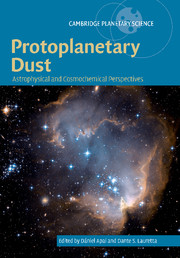Book contents
- Frontmatter
- Contents
- List of contributing authors
- Preface
- Acknowledgments
- 1 Planet formation and protoplanetary dust
- 2 The origins of protoplanetary dust and the formation of accretion disks
- 3 Evolution of protoplanetary disk structures
- 4 Chemical and isotopic evolution of the solar nebula and protoplanetary disks
- 5 Laboratory studies of simple dust analogs in astrophysical environments
- 6 Dust composition in protoplanetary disks
- 7 Dust particle size evolution
- 8 Thermal processing in protoplanetary nebulae
- 9 The clearing of protoplanetary disks and of the proto-solar nebula
- 10 Accretion of planetesimals and the formation of rocky planets
- Appendix 1 Common minerals in the Solar System
- Appendix 2 Mass spectrometry
- Appendix 3 Basics of light absorption and scattering theory
- Glossary
- Index
1 - Planet formation and protoplanetary dust
Published online by Cambridge University Press: 24 February 2010
- Frontmatter
- Contents
- List of contributing authors
- Preface
- Acknowledgments
- 1 Planet formation and protoplanetary dust
- 2 The origins of protoplanetary dust and the formation of accretion disks
- 3 Evolution of protoplanetary disk structures
- 4 Chemical and isotopic evolution of the solar nebula and protoplanetary disks
- 5 Laboratory studies of simple dust analogs in astrophysical environments
- 6 Dust composition in protoplanetary disks
- 7 Dust particle size evolution
- 8 Thermal processing in protoplanetary nebulae
- 9 The clearing of protoplanetary disks and of the proto-solar nebula
- 10 Accretion of planetesimals and the formation of rocky planets
- Appendix 1 Common minerals in the Solar System
- Appendix 2 Mass spectrometry
- Appendix 3 Basics of light absorption and scattering theory
- Glossary
- Index
Summary
Abstract Planet formation is a very complex process through which initially submicron-sized dust grains evolve into rocky, icy, and giant planets. The physical growth is accompanied by chemical, isotopic, and thermal evolution of the disk material, processes important to understanding how the initial conditions determine the properties of the forming planetary systems. Here we review the principal stages of planet formation and briefly introduce key concepts and evidence types available to constrain these.
Tiny solid cosmic particles – often referred to as “dust” – are the ultimate source of solids from which rocky planets, planetesimals, moons, and everything on them form. The study of the dust particles' genesis and their evolution from interstellar space through protoplanetary disks into forming planetesimals provides us with a bottom-up picture on planet formation. These studies are essential to understand what determines the bulk composition of rocky planets and, ultimately, to decipher the formation history of the Solar System. Dust in many astrophysical settings is readily observable and recent ground-and space-based observations have transformed our understanding on the physics and chemistry of these tiny particles. Dust, however, also obscures the astronomical view of forming planetary systems, limiting our knowledge. Astronomy, restricted to observe far-away systems, can only probe some disk sections and only on relatively large scales: the behavior of particles must be constrained from the observations of the whole disk.
However, planet formation is a uniquely fortunate problem, as our extensive meteorite collections abound with primitive materials left over from the young Solar System, almost as providing a perfect sample-return mission from a protoplanetary disk.
- Type
- Chapter
- Information
- Protoplanetary DustAstrophysical and Cosmochemical Perspectives, pp. 1 - 26Publisher: Cambridge University PressPrint publication year: 2010
- 2
- Cited by

